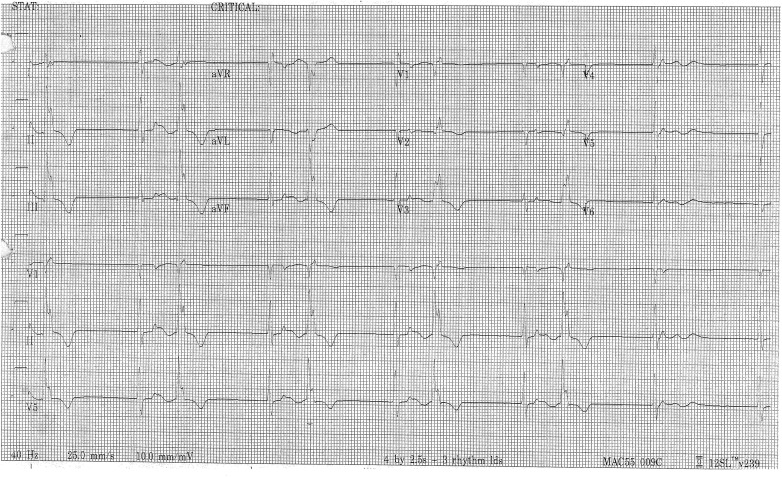A 58-year-old obese woman complained of palpitations, dyspnea, and fatigue. An electrocardiogram showed sinus bradycardia at a rate of 35 beats/min, a minimally irregular junctional escape rhythm at a rate of 49 beats/min, and, initially, escape–capture bigeminy ( Figure 1 ). The capture complexes have aberrant ventricular conduction, the result of a long R-R interval followed by a short one, the Ashman phenomenon. The R-P intervals shorten almost imperceptibly, and the following P-R intervals lengthen minimally. That and minimal slowing of the junctional rhythm result in the last P wave occurring only 0.08 seconds after the next to the last junctional escape complex, and the P wave is not conducted to the ventricles. It, however, does appear to penetrate the atrioventricular junction and to reset the junctional escape mechanism causing the last R-R interval to be 1.42 seconds, some 0.16 seconds longer than any other escape interval, an example of concealed conduction. What appear to be prominent U waves in leads II and V 4 to V 6 at the end of the tracing are probably baseline motion artifacts.

All the abnormalities on this electrocardiogram are the result of sinus bradycardia, and the patient surely has sick sinus syndrome. She has taken no drugs that might adversely affect sinus node function. An electrocardiogram recorded 8 months earlier is nearly identical to this one. A Holter monitor recording 2 weeks after this electrocardiogram shows all these iterations of sinus bradycardia and episodes of isorhythmic dissociation between sinus bradycardia and a junctional escape rhythm and sinus pauses up to 2.5 seconds. No tachyarrhythmias have been noted.
Escape–capture bigeminy can occur when the effective sinus cycle is longer than the junctional (or ventricular) escape cycle plus the refractory period of the escape complex because of sinus bradycardia, sinoatrial block, or atrioventricular block above the site of the escape rhythm. When the atrial rate increases sufficiently, the escape rhythm and the escape–capture bigeminy disappear. This patient’s symptoms have markedly diminished because her cardiac rate was increased by an electronic A-V sequential pacemaker.
Disclosures
The authors have no conflicts of interest to disclose.
See page 1484 for disclosure information.
Stay updated, free articles. Join our Telegram channel

Full access? Get Clinical Tree


